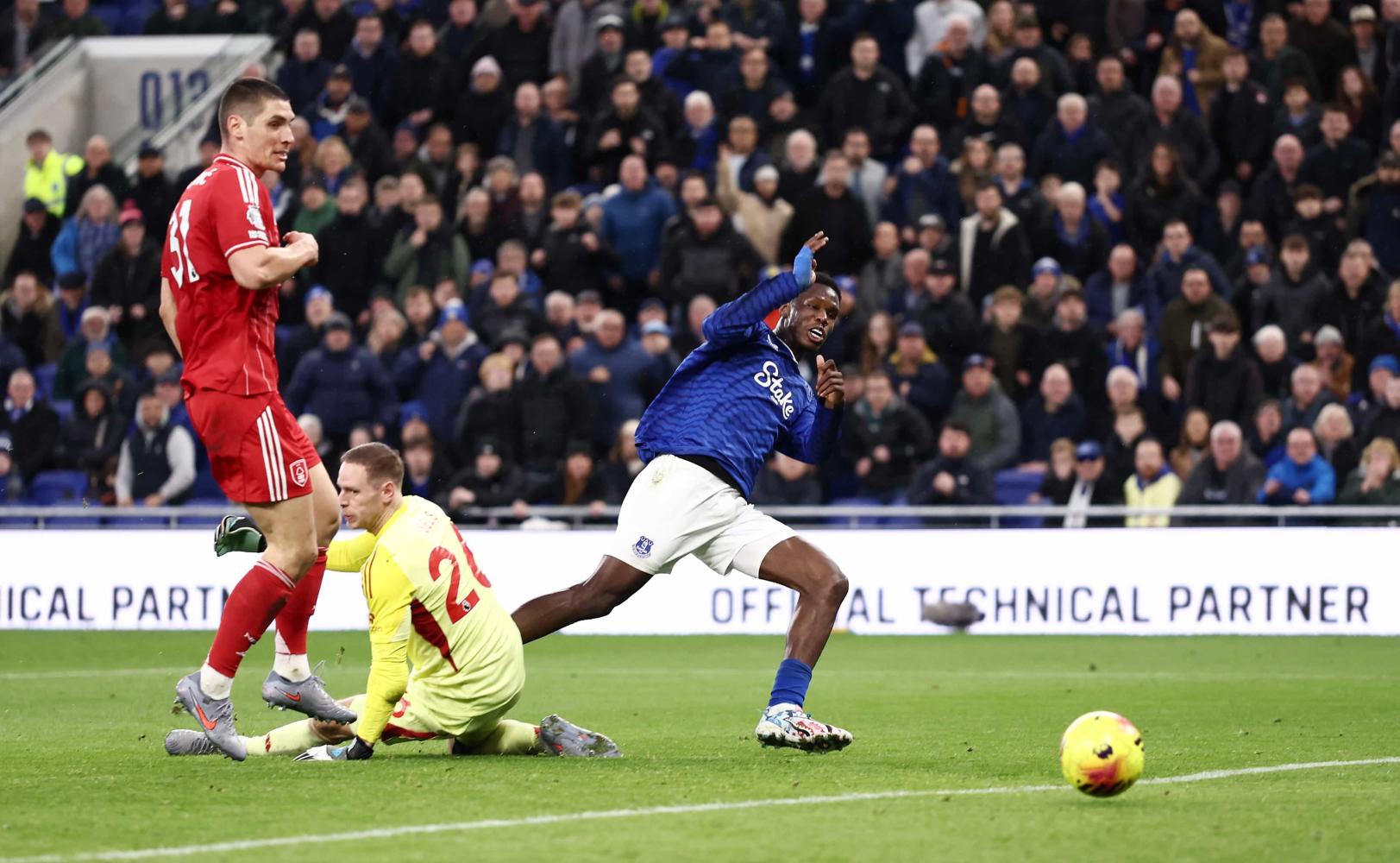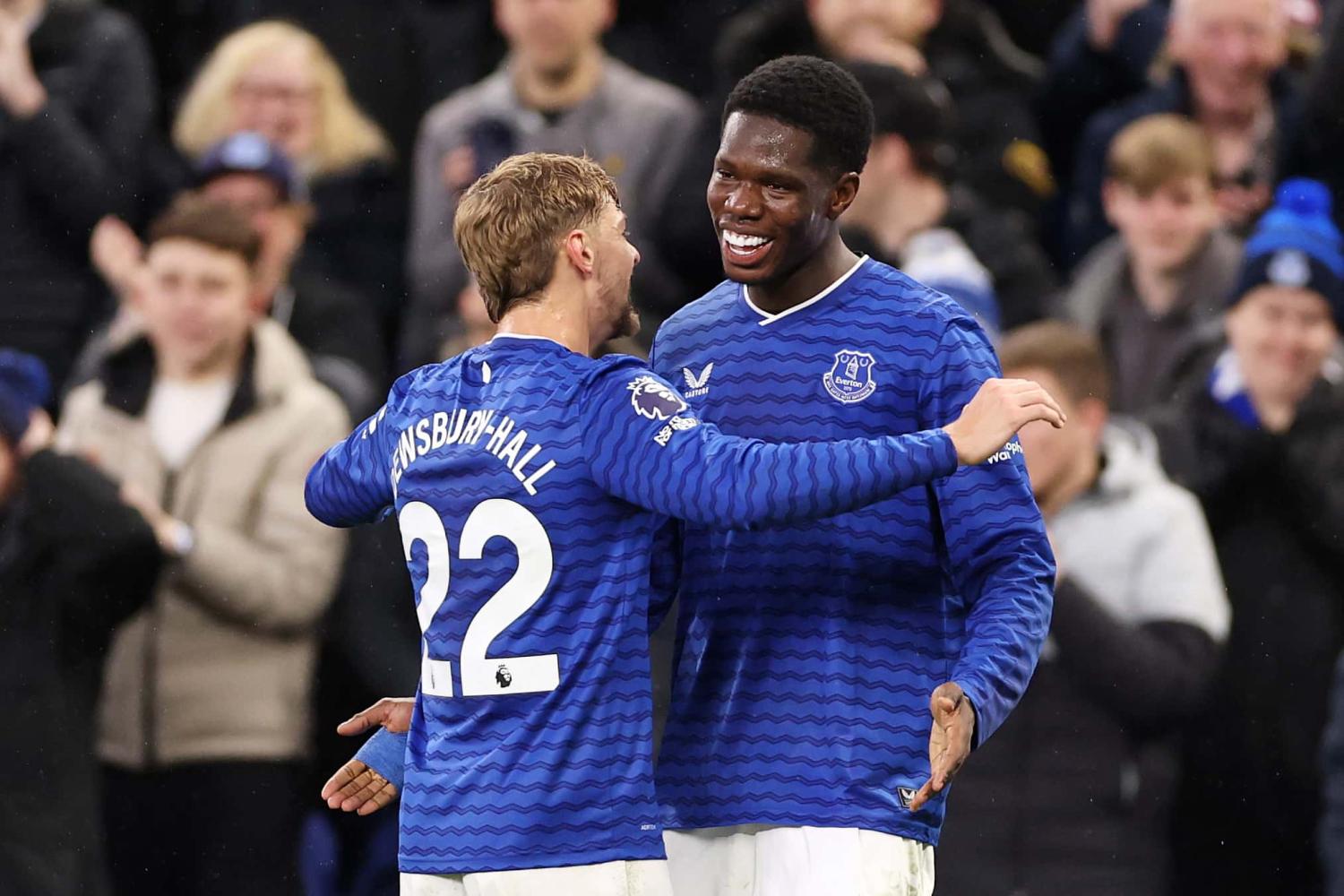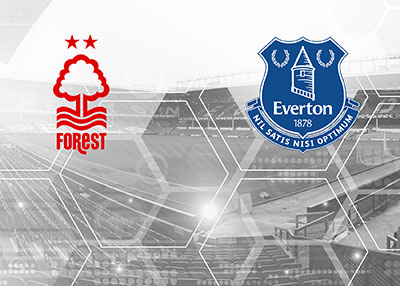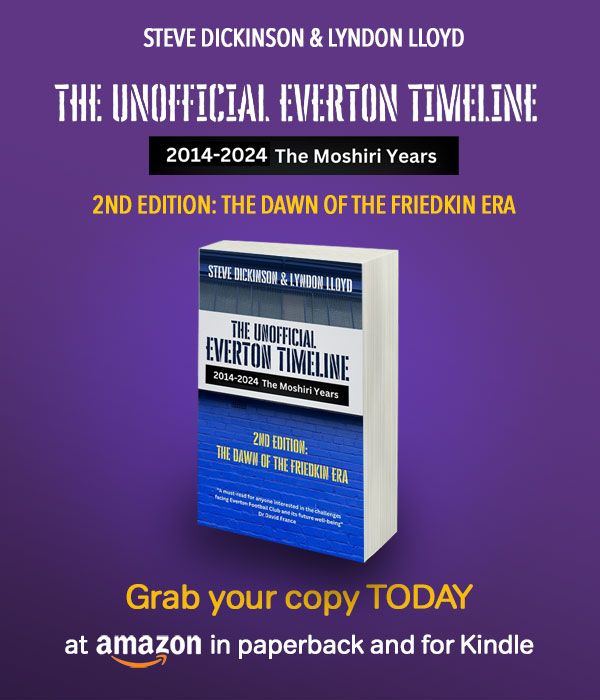You can try to find the updated link in the article archive or in the News section.
Reader Comments (47)
Note: the following content is not moderated or vetted by the site owners at the time of submission. Comments are the responsibility of the poster. Disclaimer ()
2 Posted 07/08/2025 at 09:50:50
It set me to wondering whether the reports we hear of women footballers suffering certain types of injury at a higher rate than their male counterparts could have something to do with the fact that the pitches they play on are designed for men to use?
Furthermore, could this prove to be one of the advantages of the women acquiring Goodison Park as their own home ground? The pitch there can be developed specifically to meet the needs of women footballers and, hopefully, this may lead to Everton players being less susceptible to these injuries, perhaps?
3 Posted 07/08/2025 at 09:52:39
4 Posted 07/08/2025 at 10:18:25
As interesting as your article is, I must confess that Dave's #3 made me giggle.
5 Posted 07/08/2025 at 10:20:41
I never knew you could get different grass for men or women.
Or are you just joking?
6 Posted 07/08/2025 at 10:21:37
I did comment on previous posts on this subject. Yes, the pitch, to me, did look "soft" on the foot at the 2nd test event.
I always found 3G, 4G and now 5G hardest on the legs. You would feel it in your ankles and knees for days. Much better than the original Astroturf pitches though. You would be finding sand everywhere.
In the absence of statistics, the old pitches were much worse and injury inducing. Mud baths in the winter made them hazardous and then, when they eventually dried up in the spring, as you say, hard as concrete. Equally hazardous.
Probably the worst pitches I played on were in Cyprus. Due to water restrictions, they were fed with sewage and farm fertiliser to maintain a patch of green in otherwise brown surroundings. Fine to play on, but if you caught a nick or graze, an infection followed. Nothing that mother's default cure for everything, TCP and cotton wool, couldn't sort out!!
It's common practice to re-lay the pitch before the new season, so I am sure they will get it right.
7 Posted 07/08/2025 at 10:30:56
I know it's a painful memory but the FA Cup semi-final first tie at Main Road in 1977, the pitch was terrible. The groundsman was on with a pitchfork trying to get rid of the lake in the goalmouth – no wonder Lawson was 5 yards off his line for the first goal, he would have got trench foot had he ventured further back.
Joking aside, the pitches are so much better now.
8 Posted 07/08/2025 at 10:38:43
Can't see them changing it again with only 3 weeks till it's needed.
9 Posted 07/08/2025 at 10:46:02
If you don't give it sufficient time and it is played on, the danger is it's ripped out, especially if the turf is wet.
A pitch can look nice without being fit for purpose
10 Posted 07/08/2025 at 11:03:28
I would have expected there to be a standard, validated way of laying these hybrid pitches. Hopefully we haven't just employed some divvies or tried to be revolutionary.
Until reading this, my biggest concern would have been some unforeseen microclimate effect due to positioning of stadium / steepness of terracing creating nightmare conditions when the wind blows in a particular direction or something like that.
Worrying to know someone could mess up the actual composition of the pitch.
11 Posted 07/08/2025 at 11:16:57
12 Posted 07/08/2025 at 11:24:28
Guessing now, but as the last test event was in March, and if they have relaid it for the new season, that will have presumably started back in March/April?
What you say. There's no way they would be doing it now. It wouldn't be ready.
13 Posted 07/08/2025 at 13:47:47
However, in the same way they say they are developing football boots that are specifically designed for women's feet rather than just being a smaller size, it may be that the requirements of pitch performance for women may be different to that required by men.
Having a dedicated stadium could put Everton Women at the forefront and able to reap any advantages that may be forthcoming.
14 Posted 07/08/2025 at 14:10:01
It's not at all likely that anyone is studying ‘pitch performance' with the intention of working out ‘his and hers' variants.
Clothing / equipment is a doddle to customise for the very pertinent physiological differences.
Can you think of any sport that does that in terms of the ground people run on / the snow or ice they glide on / the water they swim in?
I'll have some of whatever is fuelling your imagination.
15 Posted 07/08/2025 at 14:35:03
As explained in the OP, there is a scaffolding of synthetic fibres that mitigates against the sort of damage you are describing.
There has to be a standard methodology for installing these pitches these days. Hopefully the club haven't tried to be too innovative on something so critical to get right. The variable that is generally the most likely to be compromised is ‘time required to complete properly' due to poor / messed-up planning.
16 Posted 07/08/2025 at 14:45:23
I couldn't help but think that some of those may be different for women compared to men.
17 Posted 07/08/2025 at 15:02:14
I always stuck with Adidas Beckenbauers, World Cups or Puma Kings.
Then again, those older than me could probably talk about "Billy's Boots". Those old enough to remember reading comic books will remember.
Leather ankle boots, probably still worn back in the 50s!!
The best pitches I played on? I have to go for Germany. Decades ahead and right down to local / grass roots level. And training on clay / gravel pitches, that were smaller. It was aimed at keeping you on your feet, as you didn't want to end up with a load of gravel in your thigh or arse, and also to keep the ball and move it quickly.
18 Posted 07/08/2025 at 18:42:23
Also saves on washing the kit as nobody gets dirty. Haven't we come a long way since Clubmoor and Dwerryhouse Lane. But to be fair, even they were better than Derby's pitch.
Next you'll be telling us the ball isn't real leather any more.
19 Posted 07/08/2025 at 18:59:57
I know we are talking about elite level here, but I watch kids' footy 5 or 6 times a week and the improvement in their play when they are on 4G is huge. The passing is great, the ball fizzes across the surface.
I had not considered injury issues, but when one of the children falls on a bone-hard, sandy pitch, I cringe.
On a separate note, a friend of mine took on the upkeep of the pitch at Marine in the 1980s, and was proud of the improvements he made, and told us so now and then!
The Mariners made it to the 2nd round of the FA Cup in one of his seasons. The game was recorded, and Marine scored a cracking goal from a high clearance which became a contender for “Goal of the Month”, so was shown many times on MotD, “Sportsnight” and “Football Focus”.
The commentary went: “The ball is spending a lot of time in the air this evening – and it's no wonder, given the state of this pitch – oh, what a goal!”
We've never let him forget it!
21 Posted 07/08/2025 at 21:28:44
Dennis, for a quick way to test your hypothesis I suggested you review every other sport in existence that is played by both sexes to find anything that supports your idea. Anything come to light yet?
22 Posted 07/08/2025 at 22:51:55
23 Posted 07/08/2025 at 23:15:30
This new even fancier higher tech version seems like a solution looking for a problem.
It wasn't 'broken' - so why 'fix' it?
24 Posted 08/08/2025 at 08:12:22
Don’t let the truth get in the way of a good story. Here’s a conspiracy theory for us paranoid androids to get our teeth into … the relaying of the pitch was always planned, just like the club said ?
Despite the gossip column feel to this article, I actually enjoyed reading about grass and turf. My god I am getting old.
Also, Dwerryhouse Lane was bad, but compared to Mab Lane it was like Wembley.
UTT.
25 Posted 08/08/2025 at 09:24:03
Seems funny now to see the non-protective gym shoes the players wear now. Chuckle 🤭
26 Posted 08/08/2025 at 11:57:31
Back in the early '70s I was playing in a trial game for a West Australian team with a mate, a centre half, who I'd played with in Liverpool and a winger was breaking down the left and I screamed for him to take him out and in a way that is now rarely seen he took the ball and man over the touch line with a sliding tackle which the locals looked at in shock. As he came back to the middle of the pitch he said, "I'm not doing that again" and lifted his shorts to show two parallel grooves up the side of his thigh from about 3 inches above the knee almost to his hip where he'd hit a sprinkler head.
27 Posted 08/08/2025 at 13:10:41
The frequency of hamstring and calf strains in the modern era certainly prompts a question about the surfaces on which players not only play matches but also train. Top clubs make a significant investment in fitness and conditioning and have the benefit of greater use of substitutes, yet there seem to be many more instances of this type of injury than there were back in the 60’s and 70’s when a typical football season was played on three surfaces: grass, mud and sand.
Equally there may be some truth in the theory that top footballers are like thoroughbred horses. They are fitter, faster and hence more vulnerable to injury.
28 Posted 08/08/2025 at 13:50:59
‘Hypothesis, meaning - a supposition or proposed explanation made on the basis of limited evidence as a starting point for further investigation.’
“Furthermore, could this prove to be one of the advantages of the women acquiring Goodison Park as their own home ground? The pitch there can be developed specifically to meet the needs of women footballers and, hopefully, this may lead to Everton players being less susceptible to these injuries, perhaps?”
Do I need to define ‘perhaps?’?
You made comments that are open to debate, and I am debating them because I don’t think there is a cat in Hell’s chance of someone developing a playing surface specifically for women footballers. The massive research and development required would torpedo it financially for starters.
Mind you, I can see some enterprising chancer on Dragons Den promoting their concept of sand and bikinis as the ultimate in safety enhancement for all sportswomen.
29 Posted 11/08/2025 at 18:25:56
The studies have found that artificial turf increases the danger for women more than men, and also that women are significantly more likely to be injured playing defense, especially tackling.
Si #10, research indicates that the anatomical issue likely is not a function of the hip/pelvis differences, but rather women's hamstrings being weaker in relation to their quads -- for which shoe manufacturers are trying to compensate, as Dennis mentioned in #13.
But it seems to me that you, rather than Dennis, are the one doing all the "hypothesizing" with your speculation about the club having "poor / messed-up planning" in the turf installation.
30 Posted 11/08/2025 at 18:43:50
I was going to respond the other day but recalled that you used to be a sensible poster but since you're still flogging a dead horse. Why are you alluding to Dennis somehow being sexist in his remarks most explicitly in your last one:
"I can see some enterprising chancer on Dragon's Den promoting their concept of sand and bikinis."
As Mike points out, you're the one who doesn't know what your talking about. Surfaces have been proven to be an issue for women playing football and one that people are trying to address.
Maybe just focus on what people say instead of having already decided any mention of "women" is coming from a place of disrespect. It is as if you are over-compensating.
31 Posted 12/08/2025 at 14:59:20
I have no idea whether those involved in producing these high tech pitches have done research specifically into the requirements of women footballers, or what the outcome of any such research may be. However, it's quite clear that makes two of us, Si.
Nonetheless, I did have the temerity to wonder about it & even post about here on this site. You seem to think that because you're not aware of such a scenario in this or any other sport then it can't be & never can be a a valid consideration. The evidence for which seems to be that it's obvious to you, so surely that must be right.
No doubt you'll want to respond with the etymology of the word grass.
32 Posted 12/08/2025 at 15:16:50
I am sure technology has moved on significantly since then but
Give me grass and mud every time.
33 Posted 12/08/2025 at 20:24:27
Mike G (29), I didn’t make out, or even speculate, that EFC had messed up the pitch at BMD. Other people have, which is why this thread exists. That comment was simply about how problems can occur on long term projects for anyone. This project was started by one group in charge of the club, the club suffered some financial and organisational setbacks, and is being finished by the new owners. If there were a pitch problem (yet to be proved) I would hope it would be more likely due to a bit of ‘rushing the job’, and therefore relatively easily rectifiable, than some extraordinary/ unforeseen factor, or a poor choice of contractor who then made bad decisions.
To accuse me of being the only one hypothesising is frankly ridiculous. I haven’t claimed I’m not doing it myself (why would I?) but others clearly are as well.
Yes, Dennis did briefly mention the work done on footwear (undisputed as a sensible approach), but only to try to use it somehow to support his notion that someone is likely to be motivated to look at developing a women’s-only playing surface, which is what I dispute. (For some reason, disagreement is now not allowed on ToffeeWeb?) It is, clearly, not the potential ‘solution’ he is most interested in presenting.
Kieran (30), the comment about the chancer on Dragon’s Den is not aimed at Dennis; I don’t know why you would read it that way. I’m sure Dennis is sincere in wanting the implementation of something to lessen the risk of injury to women footballers; I just don’t see anyone developing an alternate woman-friendly playing pitch and have simply tried to explain why.
You accuse me of ‘flogging a dead horse’. Dennis has reacted to the questioning of the specific content of his posts multiple times by attacking words I have used in my posts, so I have responded by pointing out why those words were used perfectly reasonably. Now he is accusing me of simply defining my terms when it is him who is explicitly attacking my use of those terms and forcing me to publish those definitions. Why wouldn’t I show the definition of the terms he is disputing? The only ‘dead horse’ is Dennis’s capacity for coming up with sensible counter-points when his musings are legitimately questioned. Looking at his most recent post I won’t be trying to debate anything he ever posts ever again, it’s clearly a waste of time and energy.
Mike points out women are more likely to get injured on artificial turf, but that doesn’t necessarily support Dennis’s imagined solution, and it is still the particulars of a typical woman’s physiology that make her more at risk than a typical man on any surface football is played on. Have they been banned from playing on it / have any women started boycotting such pitches?
I don’t see anything in Mike’s post that suggests anyone is trying to address the increased injury risks by developing an alternate playing surface.
I didn’t sit down and research the subject when I read Dennis’s original post, I relied on memory. I’m not claiming I am an expert but I have interacted with top level female rugby players for over 30 years and I read a broad spectrum of sport, science and health related topics. I believe a trawl through my posting history would show I am not one who is at all dismissive of women participating in any level of sport they choose to.
Due to Mike and your ‘interventions’ I have gone and checked what I could fairly quickly.
Here is an excerpt from the John Hopkins Medical website:
“Sports Injury Risk Factors in Female Athletes: The Role of Anatomy
Women and girls are powerful athletes. But they may be more likely to experience certain sports injuries because of their anatomy and hormones. Female athletes and athletes assigned female at birth tend to be shorter and lighter compared to male athletes. They are also more likely to have certain anatomical features:
Wide hips: Broader hips create an angle between the hips and knees that puts stress on knee joints.
Increased joint laxity (hypermobility): After puberty, women’s joints tend to have a greater range of motion than those of men. This increases the risk of ligament injuries such as ankle sprains or anterior cruciate ligament (ACL) tears.
Strong quadriceps muscles with weak hamstrings: This combination causes an imbalance that can strain the knee and increase the odds of knee injuries.
Small head and neck: A smaller head means less ability to absorb shock. Research suggests that smaller head size and neck girth might be one reason that concussions are more common in female athletes than male. Concussion symptoms also tend to last longer in women.”
I’ve taken out a few of the points as they seemed less relevant to football, per se. I don’t think it supports your claim that I don’t know what I’m talking about as the wider hips issue is included in the list and I didn’t claim it was the only issue.
I can’t work out what your last paragraph is about. Where have I even intimated that Dennis is disrespecting women? To me, it is you who is wholly misinterpreting what you are reading.
Your last sentence is a clear insult, and I do expect an apology for that.
34 Posted 12/08/2025 at 20:32:46
I got the impression you were taking aim at Dennis based on supposition he was being sexist. People who tend to react in such a manner often are over compensating. If that was not the case then I apologize.
35 Posted 12/08/2025 at 21:54:50
Instead you seem to have read them with the idea that I was on some sort of moralistic crusade.
I do think the apology is warranted and I am also affronted by “used to be a sensible poster”, “flogging a dead horse”, “you’re the one doesn’t know what your talking about”, but I will live.
36 Posted 12/08/2025 at 22:42:07
Bluster & lies… then, eventually, an admission that you were merely saying that you "just don't see anyone developing an alternate woman-friendly playing pitch".
37 Posted 12/08/2025 at 23:30:57
There are likely plenty of specialists trying to improve pitch performance in a range of parameters but none will be doing it to develop a pitch specifically for women.
I have two last comments directed to you Dennis because you simply duck all reasonable questions and resort to trying to criticise terminology, or now just chucking insults.
Firstly, look up the difference between a definition (which has been necessary on this thread solely due to your paucity of coherent reasoning) and etymology (which wasn’t required at all).
Then look up Brandolini’s Law (and try to understand the point I’m making).
38 Posted 12/08/2025 at 23:48:33
39 Posted 13/08/2025 at 00:25:12
40 Posted 13/08/2025 at 01:32:21
You posted something absurd I asked you to back it up with something substantive. You just got defensive and restated your original thoughts. Did you not notice Paul H also questioning what you were posting?
If you can’t come up with an answer to a question you can’t just call it ‘point scoring nonsense’.
You haven’t asked me a single question regarding my stance or the information I’ve posted, the basis of which is established fact / what anyone can find on the internet. So what lies can I have told?
From the beginning my stance has been there is no current incentive to develop (i.e. bring into being something that doesn’t already exist) a pitch for women because they are more prone to certain types of injury playing football on any surface simply because of inherent differences between the sexes.
From the internet, since you don’t believe my summing up of the situation.
“While there's no definitive consensus, some research suggests that natural grass pitches may be associated with a lower risk of certain injuries for female football players compared to modern hybrid or artificial turf pitches. However, other studies indicate no significant difference in overall injury rates. The relationship is complex, with factors like field quality, player characteristics, and even the specific type of grass playing a role.”
So the research is at an impasse which means the current alternative is keeping the hybrid pitch or going back to a solely grass pitch - which comes with all the disadvantages they have which meant hybrid pitches were developed to replace them - with no guarantee that it is actually a benefit in terms of preventing injury, especially when the playing surface deteriorates and becomes more uneven / unstable because it isn’t reinforced to prevent that. I can see the Ladies complaining vehemently if you give them a solely natural grass pitch (without the research results to back it up) and they end up playing on a rutted and slippery mud-bath come February.
The current hybrid pitches were developed to play football on. If they don’t favour women that is not something that was ‘designed in’. However, they would not have been introduced if there was any obvious indication they were more injurious than what they were replacing. The men’s game is worth billions.
Until the women’s game is worth a similar amount there won’t be money to fund the necessary research and development phases which will be still vital if it isn’t a simple cut and dried answer. If there were a cut and dried answer now I’m sure there would be tonnes of people asking for it to be implemented.
There is one English club currently advocating purely natural grass pitches for women’s football, which is Brighton who have the only natural grass pitch left in use at the top level of the women’s game. They are not offering up any further research results to support their stance, nor is there any indication they are funding any. They could easily be accused of just looking to exploit their current circumstances by promoting it, without real justification, as their USP.
41 Posted 13/08/2025 at 03:27:44
To be honest mate, in fairness my response which was probably somewhat rude was a more of a cumulative build up. You and I have posted on here for a long time and I’ve always seen you as a sensible fellow like Colin Glassar, Andy Walker or Paul Tran. But that last couple of years I’ve seen a number of your posts that seem to me a bit hysterical and confrontational. I don’t want to dig through the archives but for example one poster made a comment about the disgraced charlatan Josh Wander wearing a baseball cap and you replied with a rant about Hell and people judging others appearances. I can understand the sentiment if you’re ridiculing an unfortunate who happens to be overweight, small, tall, whatever passed as a reason for school ground bullying in the eyes of idiots. But a spivy, con man who’s being sued all around the world doesn’t qualify as “shaming” their appearance in my eyes in the same way for wearing a hat. That’s one example but honestly you tend to pop up now reacting to innocent comments (in my view) like Dennis’ and it’s a bit odd and frustrating as for years I’ve always respected you as a sensible level headed bloke. So I’m sorry for the disparate remarks. If it’s any consolation it’s because I’ve always held you in a high regard. So I’m not sure why the tone of many of your posts has changed but I know you’re a smart intelligent bloke and in my awkward reactive way I’m trying to get you back to that cause you actually offer positive and interesting insights.
42 Posted 13/08/2025 at 04:13:28
Having worked with a lot of Swiss, Germans and Austrians who all seem to have been born wearing skis I can assure you there are definitely different types of snow as British Rail are also famously aware of.
Now I'm sure in competition the surfaces are manipulated to keep them in pristine condition as they also are in ice tournaments, think figure skating, an obvious example being the Zamboni.
As for swimming it's more likely chemical levels in the pool to prevent infections but not something they could control in open water events like a triathlon where you have to put up with the conditions on the day.
43 Posted 13/08/2025 at 07:00:28
John@27, in his last paragraph explains my own feelings because the game is ridiculously fast nowadays, but it’s very rare that a bad tackle is the one that causes the longer term injuries, that the players are now receiving.
I might think different if I was younger, but I honestly don’t think I’d have enjoyed playing on these modern pitches, simply because I believe they play a little bit too fast. I don’t think I could have worn these modern boots either, but maybe I could because my feet weren’t full of arthritis, when I was younger!
I think it’s sensible to have relayed the pitch, three times, and just hope that it’s made things a lot better because even the slowest player on the pitch would suffer an awful injury, if his foot gets caught in the turf, whilst he’s running or turning.
44 Posted 13/08/2025 at 07:17:26
Hard pitches are just as bad. The impact can be felt on the ankles, knees and even lower back.
I'm going back a few years now, but it made me randomly think of when the groundsmen would be instructed to narrow the pitch when marking the lines, depending on who the opposition were. I don't know if that practice still goes on.
45 Posted 13/08/2025 at 07:31:14
It must be hundreds of thousands, so relaying the pitch at BMD has been an expensive exercise for the club.
On the particular injuries that female footballers suffer from more than men (ACL, Calf, Pelvic as cited above), I would have thought that the commercials in the women's game would dictate whether club would invest in a specific turf to help offset those injuries?
It would also only be possible for women's teams who have their own ground, such as Everton.
46 Posted 13/08/2025 at 07:53:23
Link
47 Posted 13/08/2025 at 18:09:13
Kieran (41), the vast majority of my posts I try to back up with facts and reasoning, some are just an opinion (the right to which is reserved for all of us). Dennis obviously started off giving an opinion but he peppered his post with question marks which I took to being open to having his comment responded to with information supporting or disagreeing, which is all I’ve tried to do. I’ve simply tried to explain why I don’t think he will see anyone implementing his ideas.
On the purely opinion side of things, I just have a particular aversion to people effectively claiming people can be judged by aspects of their appearance. I am not looking to protect the likes of Josh Wander, just the many ordinary people who suffer from some level of discrimination because that sort of judgemental rubbish continues to be accepted behaviour because it is so often presented as if it is a specific skill people have. I do consider it to be a very unChristian attitude and will continue to attack it’s use whenever I see it.
Pete (46), mentioned in my post at (40).
48 Posted 13/08/2025 at 22:20:22
Coincidence?
Add Your Comments
In order to post a comment, you need to be logged in as a registered user of the site.
Or Sign up as a ToffeeWeb Member — it's free, takes just a few minutes and will allow you to post your comments on articles and Talking Points submissions across the site.
How to get rid of these ads and support TW











Editorial Team
1 Posted 07/08/2025 at 09:32:54
I was a bit hesitant initially as I suspected it would be another one of these wonderful scouse fear-mongering portents of doom — like the solid claim that the stadium would not be ready and Everton had already requested to play their first three games away from home.
No doubt the true story will never be revealed, however, so take it or leave it!